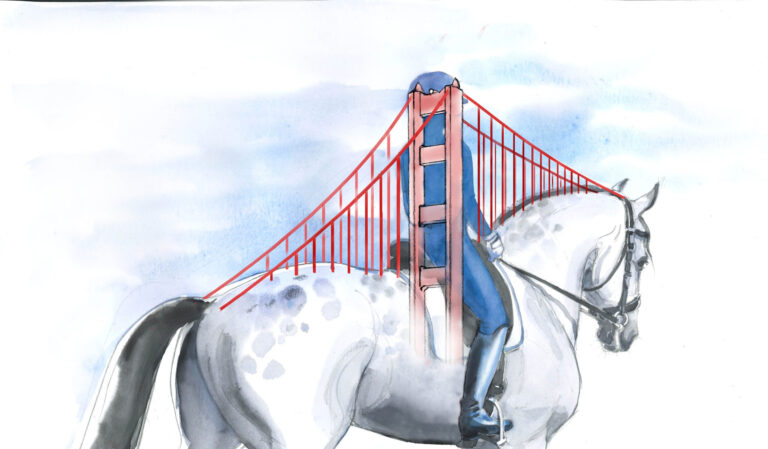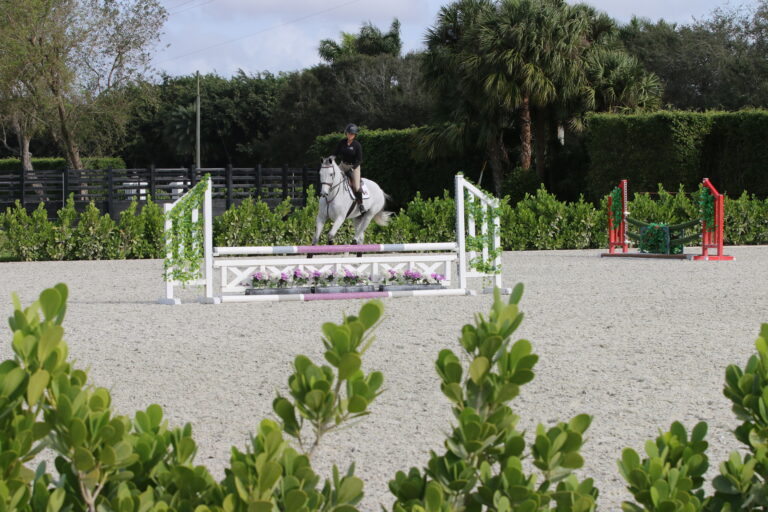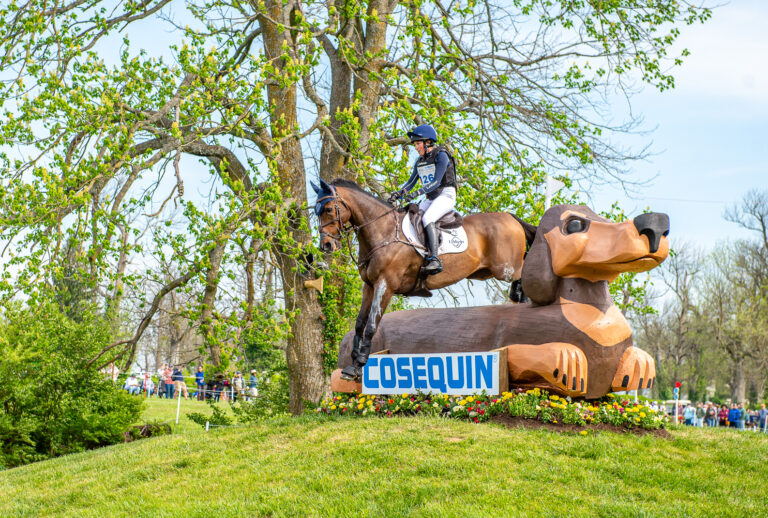 After establishing your horse’s response to your leg aids, prepare to ask for a more forward canter, which might be easier to do in a big, open space—anywhere that you feel safe and your horse feels like he has room to gallop. | © Dusty Perin
After establishing your horse’s response to your leg aids, prepare to ask for a more forward canter, which might be easier to do in a big, open space—anywhere that you feel safe and your horse feels like he has room to gallop. | © Dusty PerinQ: While galloping, each time I kick my horse, he bucks. How do I get him to stop bucking every time I kick him? I just want him to go a little faster!
ANGELA MOORE
A: Start by ruling out any physical problems that might be making galloping uncomfortable for him. Ask your veterinarian to check for medical issues that could be producing pain when you ask him to move forward. Also ask your instructor or find a qualified saddle fitter to help you check your saddle fit. Some saddles move differently with the horse at the gallop than at the other gaits. For example, your saddle may be diving down onto your horse’s withers, and his bucking may simply be his way of lowering his body to avoid this discomfort.
As an Amazon Associate, Practical Horseman may earn an affiliate commission when you buy through links on our site. Product links are selected by Practical Horseman editors.
Once you’ve ruled out any potential physical causes of your horse’s bucking, take him back to basics. Many lazy horses develop this habit when they get behind the leg: They respond sluggishly and sullenly to leg aids instead of willingly and promptly. Instead of going forward, they protest by bucking. Plan on spending several sessions reviewing the meaning of your leg cues. He must understand that he should always respond promptly to light aids.
To reinforce this lesson, you may need spurs and/or a stick. If you’re not accustomed to riding with either of these, consult your instructor about their proper use first. It’s especially important that you have a correct, steady leg position—at or behind the girth—if you intend to wear spurs. If you’re not comfortable using spurs or a whip, ask an experienced rider to work through these lessons on your horse.
Begin these sessions by practicing halt–walk transitions. Use the “ask–tell–demand” method: First, wrap your legs down and around his body and give a gentle squeeze to ask him to go forward. If he doesn’t respond immediately, follow up with a cluck and a firmer squeeze or bump against his sides with your legs. If he doesn’t respond to that, apply the spurs or stick behind your leg. Be careful to make all of these aids clear but never nagging—not spur, spur, spur.
The moment he moves forward, release your leg aids and reward him with a “Good boy!” and a pat or scratch on his withers. This reward is the critical part of the lesson. It will instill the knowledge that leg means go—and that everybody’s happy when he goes! If he breaks into trot, don’t pull him up immediately. Instead, reward him for the super response, then let him continue for a few strides before coming back to walk and asking for the transition with even lighter aids.
Repeat this transition several times until his response is prompt and obedient. Then move on to walk–trot transitions, using the same ask–tell–demand method. Next, try making transitions within the trot—asking him to go a little faster for a few strides, then slowing down for a few strides, and repeating.
For all of these upward transitions, be sure to follow his mouth forward with your hands as soon as he moves forward. Soften your elbows and lighten your weight in the saddle. This way, there’s no risk of giving him mixed messages.
It may take several sessions until your horse is responding properly and consistently to your leg aids. Take the time to solidify this basic concept at the walk and trot before trying trot–canter transitions.
Repeat the same ask–tell–demand method for trot–canter transitions. Check your position again first. Be sure your hip angle is soft, your weight is light in the saddle and you’re looking and thinking ahead. This will reinforce your “go” aids. If your hips are locked and your seat is heavy, your horse will be confused by your aids and reluctant to go forward.
Once you’re happy with the canter transitions, prepare to ask for a more forward canter. Depending on the size of the area you usually ride in, this might be easier to do in a big, open space—anywhere that you feel safe and your horse feels like he has room to gallop.
You may have to ride through a few bucks before he gets the message that he must go forward every time you ask. Check that your position is secure with your heels deep, eyes up and elbows loose. Be ready to nip his head up with one hand the moment he drops it. He can’t buck with his head up. Give this quick, upward rein aid for just one stride so you don’t discourage his forward movement while continuing to apply your leg aids. Again, if you don’t feel confident to do this safely, ask a more experienced rider to do it for you.
Be happy with the slightest improvements. If he increases his pace just a little, praise him. With repetition, he’ll learn to commit to the gallop and will actually enjoy it.
With more than 25 years of experience, Angela Moore is the head trainer at Stealaway Inc., a full-service hunter/jumper business based on her family farm in Johnstown, Ohio. A U.S. Hunter Jumper Association certified trainer, she emphasizes logical, safe, fun instruction with her students, who range from the walk/trot level to grand prix. Angela, who continues to enhance her own education by working with top professionalssuch as George Morris and Margie Engle, also has competed successfully at all levels. She and her students travel to compete at both local and AA-rated shows throughout the Midwest as well as to Florida for the Winter Equestrian Festival. Her students have earned many awards in the jumpers and equitation, including several top-10 placings in the Taylor Harris National Children’s Medal Finals as well as Kate Morrison’s individual bronze medal at the 2013 Adequan/FEI North American Junior & Young Rider Championships.











